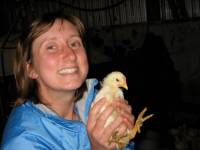Essex Farms
 I love farming. I love the people, the places and what I get to do every day. Farmers put up with a lot, and we enjoy it. Just this past week we had more than 3,000 row feet of leeks to get out of the field, and the only trouble was that the ground had frozen more than two inches thick. Normally picking leeks requires at most a pitchfork to free them from the ground, and often just a good yank, but this time however it took many layers, gloves, hats and picks and mattocks just to get them free from the frozen grasp of the now wintery ground. Then we had to pull them up, load them onto carts and pile them on the side of the field. Next we had to trim the leaves, peal away any dead material, cut off excess roots and bag them up so they are ready for storage. The pile of hundreds, maybe thousands of pounds of leeks was daunting at best, the weather was cold enough to numb your fingers and yet we all seemed to be enjoying ourselves. As I looked around, smiling at the stories that we told, I couldn’t help but notice that it is more than what I do, but also with whom.
I love farming. I love the people, the places and what I get to do every day. Farmers put up with a lot, and we enjoy it. Just this past week we had more than 3,000 row feet of leeks to get out of the field, and the only trouble was that the ground had frozen more than two inches thick. Normally picking leeks requires at most a pitchfork to free them from the ground, and often just a good yank, but this time however it took many layers, gloves, hats and picks and mattocks just to get them free from the frozen grasp of the now wintery ground. Then we had to pull them up, load them onto carts and pile them on the side of the field. Next we had to trim the leaves, peal away any dead material, cut off excess roots and bag them up so they are ready for storage. The pile of hundreds, maybe thousands of pounds of leeks was daunting at best, the weather was cold enough to numb your fingers and yet we all seemed to be enjoying ourselves. As I looked around, smiling at the stories that we told, I couldn’t help but notice that it is more than what I do, but also with whom.
One of the most fascinating facets of almost all new farmers is that they do too, in fact it is practically as if it is a prerequisite for the job. Some folks notice the same phenomenon and they take it as a warning that you must be crazy to farm. After all, why would you do something that only people who really love it do? It must be difficult, arduous, or something for only really passionate people to do it. But what does that say about the rest of the things we do? Where is the passion, the desire, the drive to do what we believe in, whatever crazy pursuit that may be?
 I have joined a new crew of excited and crazy people at Essex Farm, run by Mark and Kristin Kimball. My life here includes milking fifteen Jersey cows, making butter, yogurt, cream cheese, sour cream, cheddar cheese, butchering highland cattle and pigs, working with horses and much more, so I’m sure there will be stories to tell.
I have joined a new crew of excited and crazy people at Essex Farm, run by Mark and Kristin Kimball. My life here includes milking fifteen Jersey cows, making butter, yogurt, cream cheese, sour cream, cheddar cheese, butchering highland cattle and pigs, working with horses and much more, so I’m sure there will be stories to tell.
As a short plug for the work that Kristin does, she has just published a wonderful book called the Dirty Life, it is i the story how she ended up on a farm with her husband Mark, and the story of their first year on the farm.
New Subscription Bar
 I have finally figured out how to let readers subscribe to my blog without requiring that I remember to send out an email to a list I’ve made. I have added a “Subscribe Here” heading in the upper right hand corner of the blog and underneath is a text box where you can fill in your email address and choose to receive updates from the blog.
I have finally figured out how to let readers subscribe to my blog without requiring that I remember to send out an email to a list I’ve made. I have added a “Subscribe Here” heading in the upper right hand corner of the blog and underneath is a text box where you can fill in your email address and choose to receive updates from the blog.
WordPress makes it very easy to change your subscription or un-subscribe if you ever change your mind and don’t want to hear from me. Your email will not be used for any other purpose than to send you updates if you choose.
A Farmer Wears Many Hats
As a farmer I have worn many hats, and I mean that both literally and figuratively. I have just returned from a three month stay at Glencolton Farms, the home and farm of Michael Schmidt, a prominent figure in the national and North American raw milk debate. My intention for heading up there was to learn about dairy farming.
 As with most intentions, when it came to reality I had no idea what to expect. Except maybe early mornings, everybody knows dairy farmers get up early. I never thought I could get used to getting up at 4:40am every morning, every week, every month…but I did. Pictured here is our kitchen stove with some water boiling for the morning tea that Markus and I make. Our usual selection is stinging nettle tea, though we occasionally throw in some variation with sage, rose hip and pepper mint, all harvested from the farm. While the tea helped with the pre-five-am mornings, in the end no matter what time I went to bed 4:40 still feels normal, even on Sundays.
As with most intentions, when it came to reality I had no idea what to expect. Except maybe early mornings, everybody knows dairy farmers get up early. I never thought I could get used to getting up at 4:40am every morning, every week, every month…but I did. Pictured here is our kitchen stove with some water boiling for the morning tea that Markus and I make. Our usual selection is stinging nettle tea, though we occasionally throw in some variation with sage, rose hip and pepper mint, all harvested from the farm. While the tea helped with the pre-five-am mornings, in the end no matter what time I went to bed 4:40 still feels normal, even on Sundays.
 From five to eight in the morning the barn crew caters to the needs and whims of our cows. Olga needs a bit more straw in her bed since she is a messy cow, Liova likes a good scratch at the base of her horns before I sweep, and Lola always goes first into the parlor. The barn is set up in what is called “tie stall and gutter” configuration, this means that the cows that are being milked are chained to their stall where they are fed. The cows have plenty of space to move and lie down and they have four hours each day to be outside in the barn yard, but the rest of the day they are held in their tie stalls.
From five to eight in the morning the barn crew caters to the needs and whims of our cows. Olga needs a bit more straw in her bed since she is a messy cow, Liova likes a good scratch at the base of her horns before I sweep, and Lola always goes first into the parlor. The barn is set up in what is called “tie stall and gutter” configuration, this means that the cows that are being milked are chained to their stall where they are fed. The cows have plenty of space to move and lie down and they have four hours each day to be outside in the barn yard, but the rest of the day they are held in their tie stalls.
One of the first things we do when we get down to the barn in the morning is turn on the a mechanical gutter that we turn on twice a day to push out the manure and straw mix to the barn yard. Next the cows get their mineral supplements to keep body and digestive systems in balance. Most farmers would give their cows a calculated formula of nutrient supplements that they buy from their local supplier. Not at Glencolton.
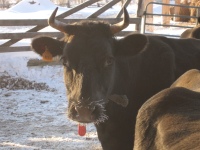 Here farm philosophies are the subject of many barn debates. And yet while any aspect of farm philosophy is open to rigorous philosophical inquiry generally the farm a biodynamic farm, based on the teachings of Rudolf Steiner. So instead of buying nutrients from somewhere else, we give the cows finely ground tree trimmings from the fence lines of the pastures. The trees, having deep roots and long lives pull a huge variety of trace elements and minerals from the ground and their leaves and twigs are an excellent sources of vitamins and minerals for the cows, and all occur naturally on the farm.
Here farm philosophies are the subject of many barn debates. And yet while any aspect of farm philosophy is open to rigorous philosophical inquiry generally the farm a biodynamic farm, based on the teachings of Rudolf Steiner. So instead of buying nutrients from somewhere else, we give the cows finely ground tree trimmings from the fence lines of the pastures. The trees, having deep roots and long lives pull a huge variety of trace elements and minerals from the ground and their leaves and twigs are an excellent sources of vitamins and minerals for the cows, and all occur naturally on the farm.
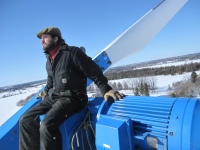 Hat #1: La boina. Is a traditional hat of Spain, and similar in style to many traditional caps all over Europe. I wear a boina in honor of the time I have spent in Spain and the way it has shaped who I am. I wear the boina as an all purpose hat; in the barn, working out in the yard, or even climbing windmills. Glencolton has a forty meter wind turbine, which has been acting up, so Markus and I climbed up to investigate and take some pictures of the area on this beautiful sunny February day.
Hat #1: La boina. Is a traditional hat of Spain, and similar in style to many traditional caps all over Europe. I wear a boina in honor of the time I have spent in Spain and the way it has shaped who I am. I wear the boina as an all purpose hat; in the barn, working out in the yard, or even climbing windmills. Glencolton has a forty meter wind turbine, which has been acting up, so Markus and I climbed up to investigate and take some pictures of the area on this beautiful sunny February day.
Hat #2: The hair-net. Usually after barn and breakfast I head down to the cheese house. The cheese house is located right next to the milking parlor and the milk comes in from the parlor after the cows are milked and is stored in a bulk tank, which you can see behind us. 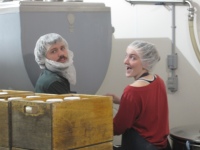 The cheese house must be kept extremely clean, that means when I first step inside the entrance-way and before going through the plastic curtain, I change my boots, my shirt, put on an apron, a hair net and the quintessential beard net (which is terribly uncomfortable I would like to add). Here Felicity and I are bottling milk, we bottle the raw milk into one and two liter bottles that have been sterilized in our industrial dishwasher. The bottles are stored in the walk in cooler in those wooden boxes you can see. We are in the process of bottling about 720 liters, or about 190 gallons of milk.
The cheese house must be kept extremely clean, that means when I first step inside the entrance-way and before going through the plastic curtain, I change my boots, my shirt, put on an apron, a hair net and the quintessential beard net (which is terribly uncomfortable I would like to add). Here Felicity and I are bottling milk, we bottle the raw milk into one and two liter bottles that have been sterilized in our industrial dishwasher. The bottles are stored in the walk in cooler in those wooden boxes you can see. We are in the process of bottling about 720 liters, or about 190 gallons of milk.
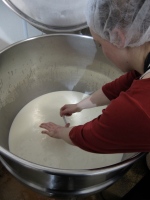
Other weekly activities in the cheese house include: making cheese, quark, cultured milk and lots of dish washing. We make many different types of cheese, though the selection varies from week to week, mostly we make soft cheese, Mountain Swiss basement cured cheese, Feta cheese, Camembert and quark. Quark is a soft spreadable cheese, similar to cream cheese, but it has more cultured tang to it. We also make a low temperature yogurt that we call culture milk. Milk used for yogurt is usually heated to 180 F (milk is usually pasteurized at 161 F) and then the culture is added and it is incubated at roughly 110 F for six to eight hours. Our culture milk is kept raw, the culture is added to the warm milk after milking, then it is bottled and put in a baking proofer which is set to approximately 125 F. It cultures there for almost 24 hours. Because of the lower temperatures the culture milk keeps the qualities of raw milk and is much less acidic than conventional yogurt.
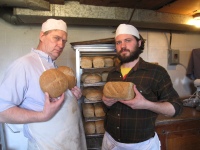 Hat #3: Bakers toque. I love to bake almost as much as I love to eat what I bake. Baking at Glencolton brings to light just how much we humans rely on grass. Grain is after all an annual grass. We took bags of our Red Fife Wheat, Spring Wheat and Spelt and put them through the mill that is behind me. It is a horizontal stone mill, which was purchased for his first farm in Germany. It will grind about fifty pounds of whole grain flour in an hour. The next step in our bread is to mix up a sponge with Michael’s sour dough starter and let that sit for a day. Next we mix up the dough and cold rise it over night, then the next morning we are ready to bake. And what marvelous bread it is, and the only imported ingredient is salt.
Hat #3: Bakers toque. I love to bake almost as much as I love to eat what I bake. Baking at Glencolton brings to light just how much we humans rely on grass. Grain is after all an annual grass. We took bags of our Red Fife Wheat, Spring Wheat and Spelt and put them through the mill that is behind me. It is a horizontal stone mill, which was purchased for his first farm in Germany. It will grind about fifty pounds of whole grain flour in an hour. The next step in our bread is to mix up a sponge with Michael’s sour dough starter and let that sit for a day. Next we mix up the dough and cold rise it over night, then the next morning we are ready to bake. And what marvelous bread it is, and the only imported ingredient is salt.
Somewhere in during this day, amidst conversations with Michael in the bakery, baking bread morphed from food product with a recipe to a philosophy: to make bread you must understand the bread. And understanding how flour of a certain grain reacts with water, time, temperature, yeast, and the air. One must understand how the texture of bread is shaped by our hands, the heat of the oven, the material of the oven, the humidity, and the variables go on. But my search for understanding makes the impossible goal of conquering those external factors an exciting philosophy. I learned to work with the bread.
In wearing these different hats; in taking on different roles in producing food I cannot help but re-evaluate how I consider food. Even as a diversified farmer there were still simple foods whose processes were undiscovered and foreign to me. They had been muddled and disguised by the way modern industrialization has taken the process of production from the local shop with clear glass windows for all to look in, and shoved it behind the stainless steel and concrete walls of government inspected facilities.
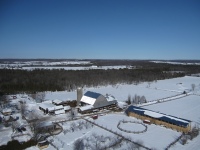 Yet from atop that windmill I could see the entire production chain of my loaf of bread: the snow covered fields where the wheat is grown, the grain bin where it is stored and cured during the winter, the bakery where the grain is milled and turned into bread, and the kitchen where we spread butter from our milk on the bread and eat it to keep the whole thing going.
Yet from atop that windmill I could see the entire production chain of my loaf of bread: the snow covered fields where the wheat is grown, the grain bin where it is stored and cured during the winter, the bakery where the grain is milled and turned into bread, and the kitchen where we spread butter from our milk on the bread and eat it to keep the whole thing going.
Raw Revolution
 If you don’t know who Michael Schmidt is then allow me to introduce him and his farm, Glencolton Farms. Michael and his family immigrated to Canada from Germany in the early 1980s where they had run a profitable biodynamic, raw milk and cheese dairy. They settled on a farm out side of Durham, Ontario, two hours drive north west of Toronto. Michael, always partial to heritage breeds purchased his first Canadienne cows, the first milk cow introduced in North America, and began selling raw milk.
If you don’t know who Michael Schmidt is then allow me to introduce him and his farm, Glencolton Farms. Michael and his family immigrated to Canada from Germany in the early 1980s where they had run a profitable biodynamic, raw milk and cheese dairy. They settled on a farm out side of Durham, Ontario, two hours drive north west of Toronto. Michael, always partial to heritage breeds purchased his first Canadienne cows, the first milk cow introduced in North America, and began selling raw milk.
If you were to ask me just a few months ago what raw milk meant to me, I would have had little to say on the subject, which is a perfect indication of how well regulations and governing bodies have hidden the subject from the public eye. Dairy, like so many other sectors of modern agriculture has morphed in the last fifty years into an industrial production system that is so complex, and I would go so far as to say convoluted that when you buy a gallon of milk it is probably one to two weeks old, has traveled thousands of miles and contains milk from hundreds if not thousands of cows. What happened to getting milk from old Bessie out back?
Luis Pasteur and his process of Pasteurization made it all possible. It is once again a neat and tidy modern solution to a simple problem, which in turn creates more problems. Pasteurization has definitely saved the lives of many a milk drinking human in the last sixty or seventy years, but saved them from what? Milk is not an inherently dangerous substance; rather it is the level of care given to producing it that can cause a public heath hazard. In my opinion the sanitation standards for modern, industrial milk production are a threat to the health of the general public.
If you were to see the feces infested barns, jammed with Holstein cows drunk on antibiotics and corn silage you would agree that it is no place to grow food. And yet we do because we can. Pasteurization allows dairy sanitation standards to be so low, in fact it is almost assumed, which is why so many regulating bodies require pasteurization of milk. It’s a bit fishy if you think about it, can you imagine if your city told you the municipal water was unsafe to drink and that you should boil it or buy bottled water? So the industry implies that it is producing an unsafe product, but don’t worry they will sterilize it before it ever touches your lips.
So what’s wrong with sterile milk? At least you know that you are not going to get sick from it, right? That is up for debate. Michael Schmidt, and many others believe that raw milk is a completely different product and that people should have the right to choose which product they want to put into their bodies. In Ontario, like many other places in North America the consumer does not have that choice, and if they do buy raw milk their farmer is breaking the law. And that is exactly what Michael Schmidt has been doing for the last thirty years, breaking the law by producing pure, delicious raw milk for his loyal customers.
Michael, did however, quickly draw the attention of the government. In 1994 he was raided by provincial authorities and fined thousands of dollars for the illegal distribution of raw milk. They sold many of their cows to cover the cost of their losses and the farm was on the brink of collapse. Michael then started his Symphony in the Barn, found new inspiration in the music and the community, and began to rebuild his farm and cow heard. He realized that he could not fight this battle alone, and he began to involve the media and the public as well as his faithful base of supporters.
He changed the legal structure of the farm so that each customer would own a “share” in a cow, entitling them to a portion of the milk. And he openly challenged the law prohibiting the distribution and thus consumption of raw milk. He opened his operation to the complete scrutiny of government eyes and offered to be inspected tested randomly to prove if what he was producing was indeed a hazard.
In 2006 the farm was raided again, this time by armed guards. And this past Thursday, January 21st, 2010 Michael Schmidt, a raw milk dairy farmer with nineteen charges against him, including the distribution of raw milk, was delivered a verdict of not guilty of all nineteen charges.

I arrived at Glencolton Farm the day Michael was told the date of this decision. The court date was only two weeks off and the days that followed were as calm as one can be with an impeding verdict to decide if what you do on a daily basis is legal or not. On the morning of the trial we had chores as usual, starting at five in the morning, but all but two members of the farm left at seven to head down to the courthouse in New Market, ON. I was one of the two farm hands that stayed behind to await any government agents that might descend on the farm if a guilty verdict was found.
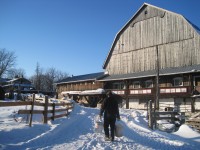 The morning was both peaceful and anxious. Sunny skies, mild weather and melting icicles were punctuated by visions of armed men confiscating equipment and trucking away our beloved cows. The judge was due to read his verdict at nine A.M. and we waited, watching each passing car on concession 2 until quarter till twelve when we received a brief and ecstatic phone call: not guilty on all accounts! So we fed the cows their usual twelve o’clock hay, ate a leisurely lunch and took a nap to celebrate.
The morning was both peaceful and anxious. Sunny skies, mild weather and melting icicles were punctuated by visions of armed men confiscating equipment and trucking away our beloved cows. The judge was due to read his verdict at nine A.M. and we waited, watching each passing car on concession 2 until quarter till twelve when we received a brief and ecstatic phone call: not guilty on all accounts! So we fed the cows their usual twelve o’clock hay, ate a leisurely lunch and took a nap to celebrate.
When Michael returned to the farm with exhausted eyes and a smile from ear to ear he hugged us all and said, “it’s not over, now we can really get started: the revolution has begun.”
Apart from the momentous event that was the not guilty ruling this last Thursday I have been an active member of Glencolton Farm for almost three weeks now. While most of my mental energy has been spent absorbing the politics, policies and history of raw milk, my physical energy is routinely exhausted in the barn and in the cheese house.
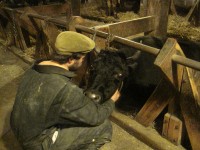 I am up at quarter to five, every morning for chores in the barn, then breakfast at eight thirty, next we have lots of miscellaneous jobs to do around the farm, including making cheese, yogurt, creme fresh, feeding the cows…etc. Then it is back in the barn at four to milk again and finish the evening chores. By nine I’m usually crawling up the stairs to my bedroom ready for sleep.
I am up at quarter to five, every morning for chores in the barn, then breakfast at eight thirty, next we have lots of miscellaneous jobs to do around the farm, including making cheese, yogurt, creme fresh, feeding the cows…etc. Then it is back in the barn at four to milk again and finish the evening chores. By nine I’m usually crawling up the stairs to my bedroom ready for sleep.
I will also report that there is no access to the internet on the farm. They have dial up in the office, which is how Michael sends his emails, but I don’t have a modem in my computer, and some days I just prefer to enjoy being back in the dark ages. Nevertheless, I hope to find time to post and communicate, and if not then I will post my writing when I am back at Meeting Place in April.
Summer
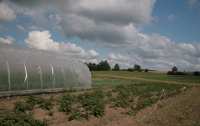
Photo credit: Seth Barch (http://www.flickr.com/photos/sethbarch)
Where does it go? Time, summer, daylight disappear in its own hurry to be off, leaving you with that seasonal yearning for it to return again soon. Since July 8th, the sun no longer wakes you every morning at 5am, the weeds have somehow grown to be taller than me, we put more than 5,000 bales of hay in the mow, peas have come and gone, song birds arrived and now seem to think that the southern hemisphere is the place to be. The general population of the farm has grown, shrunk, people have come and gone and many visitors have eaten their fill.  I had two good friends from madrid come and brave the challenges of living on a farm for a whole month. They worked with us every day, sweated in the sun, shivered in the morning dew, danced with us at a square dance, canoed and camped in Ontario and much more.
I had two good friends from madrid come and brave the challenges of living on a farm for a whole month. They worked with us every day, sweated in the sun, shivered in the morning dew, danced with us at a square dance, canoed and camped in Ontario and much more.  Jess and Christopher, two members of our team, left to pursue jobs back at Earlham where they are now happily employed. And one other fellow Earlham graduate Seth Barch decided to come up from his home in Virginia and help us out, and what a help he has been. He is a metalsmith and photographer, and since I lost my camera he has taken most of the pictures that I have posted here.
Jess and Christopher, two members of our team, left to pursue jobs back at Earlham where they are now happily employed. And one other fellow Earlham graduate Seth Barch decided to come up from his home in Virginia and help us out, and what a help he has been. He is a metalsmith and photographer, and since I lost my camera he has taken most of the pictures that I have posted here.
 As fall is rapidly closing the door on summer I find it a daunting task to try and “sum up” what the last two months have taught me. I think for now I will not try to cram anything into a few short paragraphs. Today is Friday, ie harvest day. Not a day of leisure or relaxation. This weekend I am heading north to do some canoe camping with Katrina and her parents. Then we will be back here for the final weeks of the harvest and prepare the farm for the winter. I hope to catch up on describing some of the fascinating activities that happen here. For example: haying, grain harvest, cover-croping, making beer from scratch, and much more. Until then…may your harvest be bountiful.
As fall is rapidly closing the door on summer I find it a daunting task to try and “sum up” what the last two months have taught me. I think for now I will not try to cram anything into a few short paragraphs. Today is Friday, ie harvest day. Not a day of leisure or relaxation. This weekend I am heading north to do some canoe camping with Katrina and her parents. Then we will be back here for the final weeks of the harvest and prepare the farm for the winter. I hope to catch up on describing some of the fascinating activities that happen here. For example: haying, grain harvest, cover-croping, making beer from scratch, and much more. Until then…may your harvest be bountiful.
We Are Not Alone
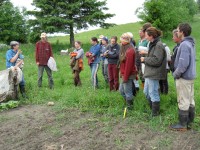 There is nothing more encouraging than an equally excited, like-minded person. Just recently our farm was filled with apprentices from other organic farms in our area who had come to the CRAFT day that we hosted here. Just like our day at Whole Circle Farm, except this time the group was much smaller, a group of farms, and their apprentices descend upon a participating CRAFT farm and learn, mingle and work with the host farmers and apprentices.
There is nothing more encouraging than an equally excited, like-minded person. Just recently our farm was filled with apprentices from other organic farms in our area who had come to the CRAFT day that we hosted here. Just like our day at Whole Circle Farm, except this time the group was much smaller, a group of farms, and their apprentices descend upon a participating CRAFT farm and learn, mingle and work with the host farmers and apprentices.
The whole local food, organic, sustainable agriculture movement has been around for a while. In the UK the organic-chemical division of agriculturalists and consumers began with the advent of chemical fertilizers after World War I. That means that ever since we started using chemicals to grow food, there have been people who believe that petroleum based agriculture is not the way we should feed ourselves. And yet, like any movement it has taken its sweet time to pick up speed, momentum and popularity. I also believe that what has hurt farming the most has been the loss of tradition.
Organic farming in the 60s and 70s was immediately associated with the hippie-back-to-the-lander who was just trying to get back to their roots. Most of them had no intention of running a business, changing the way others eat or even changing the way a national food system functions. Many ended up back in the city or compromised for the suburbs, as it turned out it was harder that it looked to survive off the land. They often had little to no agricultural or horticultural background, knowledge that would have been common sense a generation ago, was now lost to mathematical equations, history, and typing class.
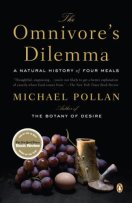 Many of us enthusiastic, aspiring farmers read the Omnivore’s Dilemma, or perhaps found Joel Salatin first and read Pastured Poultry or Salad Bar Beef, and the ingenuity of the farmers described in these books was astounding. Everything was interconnected and interdependent, all the animals and plants were integral parts of a well designed whole. What took me a long time to realize, even though Joel Salatin has stated it clearly in many interviews, was that that is the way that farming has been done for generations. All good farmers have learned to use an already functioning ecosystem of animals and plants, but many of those farmers sent their kids away telling them that farming was for the unsophisticated and the obvious became the forgotten, then the sought after, and now the new, the creative, and ironically the sophisticated.
Many of us enthusiastic, aspiring farmers read the Omnivore’s Dilemma, or perhaps found Joel Salatin first and read Pastured Poultry or Salad Bar Beef, and the ingenuity of the farmers described in these books was astounding. Everything was interconnected and interdependent, all the animals and plants were integral parts of a well designed whole. What took me a long time to realize, even though Joel Salatin has stated it clearly in many interviews, was that that is the way that farming has been done for generations. All good farmers have learned to use an already functioning ecosystem of animals and plants, but many of those farmers sent their kids away telling them that farming was for the unsophisticated and the obvious became the forgotten, then the sought after, and now the new, the creative, and ironically the sophisticated.
We were a group who, when alone, often felt as though our interests were eccentric, or at least something that one could read about, talk about but certainly not pursue as a means to make a living. Yet as we talked about our lives, experience and plans for the future you could hear the confidence grow.
When facing someone just as excited as you are it is not hard to tell them that you want to run your own farm some day, when you do they nod enthusiastically and ask you about the specifics of your operation, philosophy and geographic preferences. This is far more refreshing than the usual skeptical look of concern and the pointed inquiry: have you ever thought of the financial implications of farming? Most times I bite my tongue in lieu of firing back some curt retort about government policy and monopolistic, debt mongering agribusiness-men. I digress; it is the camaraderie and mutual enthusiasm of the group that was so inspiring.
I was reminded of a passage from the article Farmer In Chief that Michael Pollan wrote in the New York Times just before the presidential election last November. It is a lengthy quote because I found it hard to omit any part of it.
To grow sufficient amounts of food using sunlight will require more people growing food — millions more. This suggests that sustainable agriculture will be easier to implement in the developing world, where large rural populations remain, than in the West, where they don’t. But what about here in America, where we have only about two million farmers left to feed a population of 300 million? And where farmland is being lost to development at the rate of 2,880 acres a day? Post-oil agriculture will need a lot more people engaged in food production — as farmers and probably also as gardeners.
The sun-food agenda must include programs to train a new generation of farmers and then help put them on the land. The average American farmer today is 55 years old; we shouldn’t expect these farmers to embrace the sort of complex ecological approach to agriculture that is called for. Our focus should be on teaching ecological farming systems to students entering land-grant colleges today. For decades now, it has been federal policy to shrink the number of farmers in America by promoting capital-intensive monoculture and consolidation. As a society, we devalued farming as an occupation and encouraged the best students to leave the farm for “better” jobs in the city. We emptied America’s rural counties in order to supply workers to urban factories. To put it bluntly, we now need to reverse course. We need more highly skilled small farmers in more places all across America — not as a matter of nostalgia for the agrarian past but as a matter of national security. For nations that lose the ability to substantially feed themselves will find themselves as gravely compromised in their international dealings as nations that depend on foreign sources of oil presently do. But while there are alternatives to oil, there are no alternatives to food.
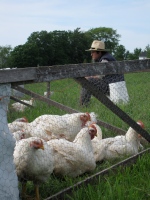 We were not the graduating class of a land-grant college, though the apprentice and intern opportunities with in the small, organic farm community are some of the best educational experiences out there, but I could not help but think we were the generation that was to become that group of “highly skilled small farmers in more places” and in our case all across the world.
We were not the graduating class of a land-grant college, though the apprentice and intern opportunities with in the small, organic farm community are some of the best educational experiences out there, but I could not help but think we were the generation that was to become that group of “highly skilled small farmers in more places” and in our case all across the world.
A New Author
Some of you may have noticed, that today’s post was not written by ItinerantFarmer. That is because we have a new author and resident here on the farm, her name is Chicum! Really I swear, that is what we call her. I hope to expand the number of authors here to give a broader, more diverse picture of life here. Enjoy!
A Day in the Life
Days here are packed. By lunchtime, the morning’s activities feel like they occurred yesterday. I’ve been wanting to give families and friends some idea of what we do here day-to-day, so I decided this morning to take some notes. So here’s what my June 29th was like, start to finish.
 At 6:20 (6:30 by Nate’s clock—we argue a lot about what time it actually is), I arose to the opening jingle of “Octopus’s Garden.” We’ve been rotating CDs as our wake-up calls, and this past week or so it’s often been the Beatles. It takes Christopher and me a couple of songs to get out of bed and dressed for the day. Downstairs, Nate has put on water for tea and we do morning stretches.
At 6:20 (6:30 by Nate’s clock—we argue a lot about what time it actually is), I arose to the opening jingle of “Octopus’s Garden.” We’ve been rotating CDs as our wake-up calls, and this past week or so it’s often been the Beatles. It takes Christopher and me a couple of songs to get out of bed and dressed for the day. Downstairs, Nate has put on water for tea and we do morning stretches.  My dad warned me how important it is to stretch when you’re farming, and we all agree—we regularly spend 20 minutes in the morning convincing our bodies that we can make it through another day. Back, legs, arms, neck… We are physically active for 8-10 hours, 6 days a week; even though we’re “young,” we feel it. Stretching really helps. We sit at the dinner table here in the lodge after stretching and drink some tea. It’s lovely to have a leisurely morning before chores and the bustle of the day begin.
My dad warned me how important it is to stretch when you’re farming, and we all agree—we regularly spend 20 minutes in the morning convincing our bodies that we can make it through another day. Back, legs, arms, neck… We are physically active for 8-10 hours, 6 days a week; even though we’re “young,” we feel it. Stretching really helps. We sit at the dinner table here in the lodge after stretching and drink some tea. It’s lovely to have a leisurely morning before chores and the bustle of the day begin.
 At 7:15, Nate heads to the garden while Chris and I set out to the shed for chicken chores. Last week we slaughtered our 180 older chickens (aren’t you glad I’m not describing that day’s work in detail?), so morning chicken chores take much less time. We still have our 200 baby chicks eating, growing, and pooping in an old iron horse stall in the shed. Each morning, we raise the brooder hood (which we lower at night to keep them warm) , check the temperature, cover the ground with new chaff from the barn, clean their water dispensers, and give them new feed.
At 7:15, Nate heads to the garden while Chris and I set out to the shed for chicken chores. Last week we slaughtered our 180 older chickens (aren’t you glad I’m not describing that day’s work in detail?), so morning chicken chores take much less time. We still have our 200 baby chicks eating, growing, and pooping in an old iron horse stall in the shed. Each morning, we raise the brooder hood (which we lower at night to keep them warm) , check the temperature, cover the ground with new chaff from the barn, clean their water dispensers, and give them new feed.  They’re eating a mix of corn, soybeans, and oats, and we throw in a couple handfuls of grit for their gizzard to help with digestion. I talk to them in funny voices (I blame Nate for that habit) and they run over and peck my muck boots with intensity. Even though the stall is large (7’x8’ or so), the chicks take up a lot of space. They zoom-zoom-zoom around, stretch out their legs, fall over, and try out their wings—you have to be careful where you step! I love chicken chores, especially in the morning because their activity cracks me up.
They’re eating a mix of corn, soybeans, and oats, and we throw in a couple handfuls of grit for their gizzard to help with digestion. I talk to them in funny voices (I blame Nate for that habit) and they run over and peck my muck boots with intensity. Even though the stall is large (7’x8’ or so), the chicks take up a lot of space. They zoom-zoom-zoom around, stretch out their legs, fall over, and try out their wings—you have to be careful where you step! I love chicken chores, especially in the morning because their activity cracks me up.
This morning, Chris realizes that we need another feeder to keep up with their appetites, so he heads out to the now empty chicken tractor hutches out the field that used to house our 200 adult chickens. He comes back with the feeder and news that (surprise!) there’s still one adult chicken left that we somehow missed last week when we did the processing. Miraculously, this Jesus bird (that’s what I named her) survived since Thursday with no food and a hutch completely open to predators. Not mention she managed to camouflage herself last week when we were rounding them up for slaughter. Crazy!
With chicken chores done, we then head down the garden, where we meet Nate to plant about 40 young brasica plants, including giant red mustard, moi toi, mitzuna, and tat soi . This was high on our priority list, since it is supposed to rain for the rest of the week. We surrounded each plant with a steel can and then covered them all with row covers, which should help with pest control during their first few days outdoors. All this done before breakfast!
At 8:00, we meet back at the house, returning from the various chores we each do. Every day is the same breakfast—oatmeal with raisins and chopped apple, and a blended-up powdery mix of pumpkin seeds, sunflower seeds, and flax seeds. Healthy and hearty! My own personal addition is a handful of chocolate chips, which makes me feel healthy and happy. We eat out on a screened-in porch with a cement floor, which also holds a fridge and freezer for our harvests and meat. We sit and chat over oatmeal about the weekly schedule, the expected weather, high-priority tasks, and today we talk a lot about our Jesus bird. How did she survive? How did we miss her? What do we do with her now? We divvy up tasks and head out to work again.
 By 8:45, Nate, Chris, Mark (a WWOOFer), and I head down to the garden. We have a lot to get done before it starts raining, and it is looking imminent. The guys continued covering the young brasicas, but I went straight to the hoop houses. For the next couple of weeks, I’m in charge of irrigation. We use drip tape in the hoop houses, which I helped Fran clean, test, connect, repair, and lay last week. It should be all set for connection to the hose, but something always seems to go awry—geysers spew from pinholes in the tape, joint fittings explode, the water pump breaks, etc. This morning, I planned on watering our peppers. I noticed 4 pinholes when I turned on the hose—easy to fix with a rag, Leatherman, Tuck tape, and patience. It’s been a bit of a challenge to figure out the correct water pressure so that the bed is watered thoroughly after 6 hours. It’s entertaining (though occasionally frustrating) to experiment and tinker with the system. After 45 minutes I finally have the irrigation working again, but it prompts me to dream of more efficient and logical ways to water our plants. Nate calls me on the walkie-talkie to go get harvest buckets from the greenhouse, so I gather them and return to the garden for morning harvest.
By 8:45, Nate, Chris, Mark (a WWOOFer), and I head down to the garden. We have a lot to get done before it starts raining, and it is looking imminent. The guys continued covering the young brasicas, but I went straight to the hoop houses. For the next couple of weeks, I’m in charge of irrigation. We use drip tape in the hoop houses, which I helped Fran clean, test, connect, repair, and lay last week. It should be all set for connection to the hose, but something always seems to go awry—geysers spew from pinholes in the tape, joint fittings explode, the water pump breaks, etc. This morning, I planned on watering our peppers. I noticed 4 pinholes when I turned on the hose—easy to fix with a rag, Leatherman, Tuck tape, and patience. It’s been a bit of a challenge to figure out the correct water pressure so that the bed is watered thoroughly after 6 hours. It’s entertaining (though occasionally frustrating) to experiment and tinker with the system. After 45 minutes I finally have the irrigation working again, but it prompts me to dream of more efficient and logical ways to water our plants. Nate calls me on the walkie-talkie to go get harvest buckets from the greenhouse, so I gather them and return to the garden for morning harvest.
 Peas are everywhere. We have nine 150-feet rows of shell peas and a double row of climbing snow peas and they are bursting with ripe bounty. We work straight for an hour and I’ve nearly picked a full bucket and eaten several handfuls. As they pile up, I wonder what we’ll do with all of them since we don’t have a market until Saturday. At 10:00 we see Tony go by on the 100 year-old riding row cultivator, pulled by Peg and Sharlene, two of our Belgian draft horses.
Peas are everywhere. We have nine 150-feet rows of shell peas and a double row of climbing snow peas and they are bursting with ripe bounty. We work straight for an hour and I’ve nearly picked a full bucket and eaten several handfuls. As they pile up, I wonder what we’ll do with all of them since we don’t have a market until Saturday. At 10:00 we see Tony go by on the 100 year-old riding row cultivator, pulled by Peg and Sharlene, two of our Belgian draft horses.  Tony calls us over at 10:30 to demonstrate how he row-cultivates the field corn. It’s astonishing how powerfully and precisely the horses move and how simple, antique machinery still make sense. In no time at all, the field is nearly free of weeds. We return to picking peas, which seems an endless task. By noon, we finished with 5 rows of the shell peas. This last Friday, we harvested 5 gallons of shell peas. This morning alone, we picked 20 gallons.
Tony calls us over at 10:30 to demonstrate how he row-cultivates the field corn. It’s astonishing how powerfully and precisely the horses move and how simple, antique machinery still make sense. In no time at all, the field is nearly free of weeds. We return to picking peas, which seems an endless task. By noon, we finished with 5 rows of the shell peas. This last Friday, we harvested 5 gallons of shell peas. This morning alone, we picked 20 gallons.
Lunch usually starts around 12:30 here. We eat sandwiches with every kind of bizarre topping. Today was especially eclectic. I had three open-face sandwiches—two with cream cheese, spinach, sour kraute, mayo and mustard on homemade bread and one with macadamia-cashew butter and apple butter (which comes from the orchard here). It still hasn’t rained, so we are quick to get back outdoors. Normally we take a nap after lunch until about 2:30 or 3:00, but we’ve got too much to do today. More peas!
 We are back to picking by 1:30, and once it starts raining we work in the hoop house tying up tomatoes and hoeing between rows to kill young weeds. It rains on and off for the rest of the afternoon, so we hop back and forth between the rows of peas and the hoop houses. We don’t finish picking the snow peas, but by 5:00 we have nearly 5 gallons of them. Incredible! We usually don’t stop working until dinner is ready, but today we quit early just after 5 pm. Tony is on dinner prep today (we alternate); I’m not too excited about his liver and onions menu. .. That said, we do eat really well here. All our meat and vegetables come from the farm, and we make bread, mayo, wine, cheese, apple butter and other things from scratch. Fran also cans and freezes fruits and veggies every year, so we have quite an array of foods to cook with. The liver and onions, as expected, aren’t my favorite, but there are several leftovers I can use to supplement my meal.
We are back to picking by 1:30, and once it starts raining we work in the hoop house tying up tomatoes and hoeing between rows to kill young weeds. It rains on and off for the rest of the afternoon, so we hop back and forth between the rows of peas and the hoop houses. We don’t finish picking the snow peas, but by 5:00 we have nearly 5 gallons of them. Incredible! We usually don’t stop working until dinner is ready, but today we quit early just after 5 pm. Tony is on dinner prep today (we alternate); I’m not too excited about his liver and onions menu. .. That said, we do eat really well here. All our meat and vegetables come from the farm, and we make bread, mayo, wine, cheese, apple butter and other things from scratch. Fran also cans and freezes fruits and veggies every year, so we have quite an array of foods to cook with. The liver and onions, as expected, aren’t my favorite, but there are several leftovers I can use to supplement my meal.
Evenings pass quickly because we are usually exhausted. We all feel ready for bed by 8:30 or so, but the sun doesn’t go down until after 10 pm. So, after dinner we come back to the lodge, listen to music, and Nate and I work on our blog entries. While I can list what we accomplished today, it is much more difficult to describe the feeling it gives you to have your hands dirty all day, to harvest delicious food, and to see baby animals grow. I go to sleep tired and satisfied, then dream of peas, chickens, and weeds. Every day is different, but I hope this gives you all an idea of what it’s like for us out on the farm. Come visit us and see for yourselves! ☺
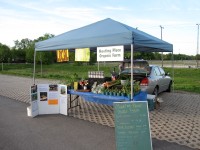 Green vegetables, the ever-feared, always-loathed food group that so many of us tried our best to avoid as our taste buds were developing. It’s a wonder that Popeye convinced any of us that spinach was worth eating, but somehow I got past that stage and I am now the proud arch nemesis to many unsuspecting young teens in the Stratford area. It’s not often, but every once and a while we come face to face, my enemy and me. Imagine you’re thirteen, the only green in your diet are green apple air-heads and the last thing you want to do at eight am on a Saturday morning is walk around with your mom among a hoard of people that think like her. If it weren’t for the borderline blackmail agreement you made with her last night about getting ice cream with your friends later that Saturday, you would still be in bed. I stand behind my wall of green things, with a frightening number of other potted plants that probably produce similarly terrifying vegetables. And not to mention the Apple Butter, if you thought apple sauce was bad, this stuff is darker, stickier and a far cry from its claimed main ingredient: the apple. But it’s not the green stuff, per se, that is so daunting, rather the conversation that ensues:
Green vegetables, the ever-feared, always-loathed food group that so many of us tried our best to avoid as our taste buds were developing. It’s a wonder that Popeye convinced any of us that spinach was worth eating, but somehow I got past that stage and I am now the proud arch nemesis to many unsuspecting young teens in the Stratford area. It’s not often, but every once and a while we come face to face, my enemy and me. Imagine you’re thirteen, the only green in your diet are green apple air-heads and the last thing you want to do at eight am on a Saturday morning is walk around with your mom among a hoard of people that think like her. If it weren’t for the borderline blackmail agreement you made with her last night about getting ice cream with your friends later that Saturday, you would still be in bed. I stand behind my wall of green things, with a frightening number of other potted plants that probably produce similarly terrifying vegetables. And not to mention the Apple Butter, if you thought apple sauce was bad, this stuff is darker, stickier and a far cry from its claimed main ingredient: the apple. But it’s not the green stuff, per se, that is so daunting, rather the conversation that ensues:
 “And do you know what this is?” I ask, gesturing to a bunch of horrifically coarse and furry leaves that you hadn’t noticed before. “No” she replies with a dreaded tone of interest that always means something-new-to-try for dinner.
“And do you know what this is?” I ask, gesturing to a bunch of horrifically coarse and furry leaves that you hadn’t noticed before. “No” she replies with a dreaded tone of interest that always means something-new-to-try for dinner.
“This is comfrey” I explain, holding the bouquet of leaves as if it were a dozen roses. Her eyes grow wider as her mind begins to fathom its potential health benefits, “how do you prepare it?” she asks trying to not sound ignorant or desperate. As I explain its nutritional and homeopathic traits as well as its many culinary uses you can picture it in your minds eye: the putrid green pile of now felt textured, spinachesque vegetable matter that is plopped with pride onto your dinner plate; a new vegetable for you to try! I can see all of this behind your blank stare, and my knowing smile is all that much more infuriating so you tell your mom you’re going to wait in the apple fritter line.
 If it is not comfrey that you fear, than maybe it is the “Zesty Salad Mix,” just the descriptor “zesty” is enough to make you cringe. You thought iceberg lettuce was manageable with a fair allotment of Kraft Fat Free Ranch salad dressing, but somehow these greens can’t be hidden behind even the strongest artificial flavors. Even the heads of lettuce don’t look like they should, some leaves look glossy, some have a more colorful matte finish and none come neatly shrink wrapped. It was as if your mom finally found that store of vegetable ammunition, which she has been threatening you with for so long. That’s right, I’m that dangerous, and it’s only going to get worse as the spring turns to summer.
If it is not comfrey that you fear, than maybe it is the “Zesty Salad Mix,” just the descriptor “zesty” is enough to make you cringe. You thought iceberg lettuce was manageable with a fair allotment of Kraft Fat Free Ranch salad dressing, but somehow these greens can’t be hidden behind even the strongest artificial flavors. Even the heads of lettuce don’t look like they should, some leaves look glossy, some have a more colorful matte finish and none come neatly shrink wrapped. It was as if your mom finally found that store of vegetable ammunition, which she has been threatening you with for so long. That’s right, I’m that dangerous, and it’s only going to get worse as the spring turns to summer.
What you don’t know is that I used to be like you; my mother had to hide peas in my pancakes to try and get me to eat something green. And what you cannot even begin to fathom is that someday you might be like me. I love my “job” and what’s more I love the life that comes with it, and I don’t think I’m alone. The New York Times recently ran an article in the”Dining and Wine” section that describes the recent trend of liberal arts students that have chosen to see what this whole farming thing is about. It is not your typical job, life is put into your hands from the moment you step foot on the farm: often times animals depend on you for food, and vice versa.  You have to be creative, imaginative and when a chicken pecks you when you try to feed him and then poops on you when you do it helps to have a sense of humor. Take this mustard flower to the right. They litter our pastures and the flower is a burst of sweet flavor backed by your typical mustard gusto. This yellow delight of flavor is now the newest garnish in our zesty salad mix and just one of the creative ideas that bounce around on this farm.
You have to be creative, imaginative and when a chicken pecks you when you try to feed him and then poops on you when you do it helps to have a sense of humor. Take this mustard flower to the right. They litter our pastures and the flower is a burst of sweet flavor backed by your typical mustard gusto. This yellow delight of flavor is now the newest garnish in our zesty salad mix and just one of the creative ideas that bounce around on this farm.
It is not surprising to me that liberal arts students, like myself, are drawn to farming. It is like the best of essay topics, given by that imortal Humanities professor who always manages to instill that ever illusive self-kindled inspiration. The question challanges some personal part of your intelect, it makes you dig deep into your mental and moral priorities: what is it that I care about? And you know before you start that nothing but honest comitment and perserverence will come close to uprooting the answer.
Chicken Love and Death
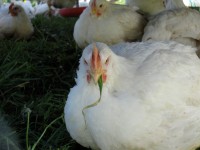 I think I am in love with chickens. Not in that romantic way that people mean when they say it to one another, rather I could sit and watch them and never get bored. They have such comical mannerisms and idiosyncratic motions, they always seem to be either in an extreme hurry to do whatever life necessity is happening, or they can not be bothered to do more than blink from their ruffled spot in the corner of the pen. I often get a hearty chuckle or bemused smile when I get caught just watching them. It was as if there were mini dramas playing out in every corner because life is a free-for-all of who gets the prime spot at the feeder. No one else here seems to find the same humor in their ways but it never fails to make me smile.
I think I am in love with chickens. Not in that romantic way that people mean when they say it to one another, rather I could sit and watch them and never get bored. They have such comical mannerisms and idiosyncratic motions, they always seem to be either in an extreme hurry to do whatever life necessity is happening, or they can not be bothered to do more than blink from their ruffled spot in the corner of the pen. I often get a hearty chuckle or bemused smile when I get caught just watching them. It was as if there were mini dramas playing out in every corner because life is a free-for-all of who gets the prime spot at the feeder. No one else here seems to find the same humor in their ways but it never fails to make me smile.
This week the roosters are really starting to show their combs and wattles and they have begun to face off against one another as the other more smoothed headed hens look on apathetically. It seems appropriate that as they grow and mature so too does their set on which so many dramas unfold: this week I we moved them out to pasture.
 It was a messy, squaking journey from the shed to the pasture where we had set up the four “chicken tractors” for the now two hundred and four chickens. A chicken tractor is basically a portable chicken pen that we drag around the pasture so the chickens can eat grass, grubs and many other goodies as they drop their own precious, nitrogen rich goodies on the soil. The tractors are a wooden frame covered in chicken wire, with most of the roof and sides covered with a white plastic to give them shade and shelter from the elements. They have an automatic waterer hooked up to our livestock, gravity fed watering system, and a feed trough.
It was a messy, squaking journey from the shed to the pasture where we had set up the four “chicken tractors” for the now two hundred and four chickens. A chicken tractor is basically a portable chicken pen that we drag around the pasture so the chickens can eat grass, grubs and many other goodies as they drop their own precious, nitrogen rich goodies on the soil. The tractors are a wooden frame covered in chicken wire, with most of the roof and sides covered with a white plastic to give them shade and shelter from the elements. They have an automatic waterer hooked up to our livestock, gravity fed watering system, and a feed trough.  Every morning we move them to a new patch of grass, check their water and give them feed, and they sure can eat. When they were just a week old the whole batch of them would eat a few scoops of feed a day, probably no more than a few pounds. Today they are six weeks old, and we feed them about a hundred to one hundred and twenty pounds of feed a day. And that is assuming that they are getting a good thirty percent of their daily calories from the pasture. That is more than half a pound of feed, per bird, per day and they only weigh about four to six pounds each. That is roughly a tenth of their body weight, it would be like if I tried to eat seventeen pounds of food everyday.
Every morning we move them to a new patch of grass, check their water and give them feed, and they sure can eat. When they were just a week old the whole batch of them would eat a few scoops of feed a day, probably no more than a few pounds. Today they are six weeks old, and we feed them about a hundred to one hundred and twenty pounds of feed a day. And that is assuming that they are getting a good thirty percent of their daily calories from the pasture. That is more than half a pound of feed, per bird, per day and they only weigh about four to six pounds each. That is roughly a tenth of their body weight, it would be like if I tried to eat seventeen pounds of food everyday.
 There are of course, dangers to being outside, exposed to all the dangers of what chance has to offer. This morning, as we moved the tractors to their new spot, the dinner menu changed. Out from the under the dragging end of the one of the tractors rolled two chickens. They both looked well feathered out, and healthy, except that they were no longer alive. And there were suspicious looking red spots just below both chicken’s heads. My immediate reaction was vampires, and my guess was not far off. Skunks and weasels will catch and kill a chicken through chicken wire and then suck the blood from its neck. Since it cannot get the bird through the chicken wire, it will then leave the dead bird and often kill again. This time we were lucky, it only took two, so chicken was on the menu tonight. You can’t get chicken much fresher than that, and it doesn’t get much better either.
There are of course, dangers to being outside, exposed to all the dangers of what chance has to offer. This morning, as we moved the tractors to their new spot, the dinner menu changed. Out from the under the dragging end of the one of the tractors rolled two chickens. They both looked well feathered out, and healthy, except that they were no longer alive. And there were suspicious looking red spots just below both chicken’s heads. My immediate reaction was vampires, and my guess was not far off. Skunks and weasels will catch and kill a chicken through chicken wire and then suck the blood from its neck. Since it cannot get the bird through the chicken wire, it will then leave the dead bird and often kill again. This time we were lucky, it only took two, so chicken was on the menu tonight. You can’t get chicken much fresher than that, and it doesn’t get much better either.
In memory of a dear friend of mine I roasted the chickens with a lemon inside, some potatoes around the edges of the pan, and then basted the whole bird with a mixture of garlic, chicken fat and thyme. It wasn’t seventeen pounds of food per person, but no one complained either.

